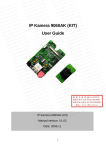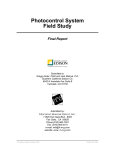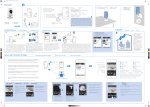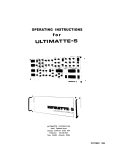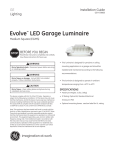Download AWG LITE PACK FOR NSD LITE Specifications
Transcript
LightSaver® LS-101 Daylighting Controller SPECIFICATIONS Light Sensor range . . . . . . . . . . . . 1 to 1400 fo o tcandles ON Setpoint range . . . . . . . . . . . . . . 1 to 850 fo o tcandles Automatic Deadband. . . . . . . . . . . 25%, 50%, 75%, 100% Status Indica tor . . . . . . . . . . . Multi-function green LED Power requirements . . . . . . . . . . 12/24 VDC, min 10 mA Total power requirements are dete r m i n e d by the controlled device. Output signal . . . . . . . . . . . . . . . 12/24 VDC, max 120 mA Location . . . . . . . . . . . S u i table for dry, interior locations Environment . . . . . . . . . 50° to 104° F, less than 90% rh Dimensions . . . . . . . . . . . . . 2 . 4” diameter x 0.7” depth (61mm x 17mm) Figure 1: LS-101 DESCRIPTION The Watt Stopper LS-101 is an interior photosensor that automatically turns a zone of lights ON and OFF based on daylight levels. It is a low voltage device intended to signal a power pack or relay panel. The LS-101 is designed to require minimal adjustment at startup. For more advanced applications, an onboard display and two pushbuttons allow for adjustments, if needed. The display is hidden under a removable cover. To assist with adjustment, the LS-101 displays the current light level reading. Figure 2: Cover removed The LS-101 is designed to be either ceiling- or wallmounted. It has a wide range light sensor capable of measuring from 1 to 1400 footcandles. SELECTING A LOCATION The LS-101 controls lights in areas that rece i ve enough daylight so that the electric lights can be reduced or switched OFF. It is important to select a location for the LS-101 where the daylight is representa t i ve of the daylight throughout the controlled zone. Note the path of shadows. Daylighting co n t rol will be problematic if part of a controlled zone is in shadows while another part has plentiful daylight. Figure 3: LS-101 Field of view, sidelight application When the primary source of daylight is a skylight (toplighting), there are several options for mounting the LS-101. The recommended mounting locations are shown in Figure 4. Ideally, the sensor is mounted on the South sidew a l l looking North across the light well. It could also be mounted on the ceiling next to the skylight, looking down at the floor. A skylight may produce 5000 footcandles or more. If the sensor is mounted so that it looks up into the skylight, the daylight will exceed the maximum OFF setpoint of 1275fc which is too low for this orientation. When the primary source of daylight is a window (sidelighting), the LS-101 is typica l ly ceiling mounted within the daylit zone which extends 12 feet or le ss in from the window. A good location is often between the window and the first row of fix t u res. Figure 3 shows a typical mounting location for a sidelit application. Figure 4: Copyright© 2007 Watt Stopper/Legrand ® LS-101 Skylight application 07076r2 4/2007 Closed Loop or Open Loop Invert output The LS-101 can be used as a closed loop device or as an open loop device. When the LS-101 can view both daylight and light from the co n t rolled electric lights, it is working as a closed loop device. When the LS-101 can only see daylight, it is working as an open loop dev i ce. This feature is used to control devices that require a +24 VDC signal when the lights should be turned OFF and 0 VDC when the lights should be turned ON. The normal operation of the L S-101 provides a +24 VDC signal when the lights should be turned ON, but using this feature, the operation can be reve rsed from the Adjustment Menu Setup display to satisfy the applica t i o n . In both cases, having adequate separation of the ON and OFF setpoints is important. When working in closed loop mode, it is critical to have enough separation between the ON and OFF settings (known as deadband) to co m p e n s a te for the reduction of the controlled lights. If not, when the controlled lights switch OFF, the light level will fall below the ON setpoint and the lights switch back ON. OPERATION The LS-101 features adjustable ON and OFF setpoints, OFF time delay as well as seve ral features to simplify adjustment. For basic operation, these three paramete rs are all that may need to be adjusted. While the ON and OFF setpoints are independently adjustable, the LS-101 features a built-in minimum deadband. Therefore, these two setpoints are always automatically separa ted by at least a minimum amount of deadband. When the sensed light level drops below the ON setpoint for 20 seconds, the output signal switches ON. In the LS-1 0 1 ’s default operation, this means that the LS-101 provides 24 VDC on the output (blue wire) when the lights should be ON. However, it is also possible to invert the output sta te. (Please see “Invert output” for further explanation.) Adjusting the ON setpoint also automatically adjusts the OFF setpoint to maintain the programmed deadband. Once the ON setpoint is changed, you can further adjust the OFF setpoint. In applications where the LS-101 sees the lighting from the controlled fix t u res, it is important to have the ON and OFF setpoint separated by a deadband of at least as much as the light provided by the controlled fix t u re. Test Mode The Te st mode temporarily shortens all of the time delays so that the light level switching functions can be quickly te sted. Te st mode is invoked in the installation process in two ways. • A f ter either an ON or OFF setpoint has been changed, the L S-101 remains in Test mode for one minute. The LED blinks ON and OFF rapidly to indica te Test mode. During this minute, te st the LS-101 operation by either blocking the light reaching the sensor or by shining a bright light i n to the sensor. At the end of the minute, the normal time delays are reinsta ted. Wall switch override The LS-101 provides a connection for an optional low voltage, normally-open, momentary-contact wall switch override. This switch can be used to temporarily turn the lights ON when the LS-101 has switched them OFF because the light level is above the setpoint. When the wall switch is pressed, the lights switch ON, and automatic light level control is temporarily suspended for one hour. If during this period the wall switch is pressed again, the override is ca n celed and the lights are re stored to automatic control. The wall switch requires a two wire momentary switch. See Figure 10 for more information. Hold ON while occupied This is an optional feature that prohibits high light levels from turning OFF the controlled light as long as the space remains occupied. This feature allows energy savings from daylighting control while limiting impact on occupants who might be distracted or annoyed if the lights switch OFF while they are in the space . This feature requires that the signal wire from an occupancy sensor be co n n e c ted to the LS-101. See Figure 9. The LS-101 will not switch OFF while an occupancy signal (+24 VDC) is present on the white wire. This function is enabled or disabled from the display’s Adjustment Menu SETUP submenu. It allows the occupancy signal to be connected to the LS-101 at installation but later be ignored without having to disconnect it. INSTALLATION The LS-101 is designed to be mounted in either of two ways. For suspended ceiling tile, a threaded nipple with a lock nut is attached to the L S-101. See Figure 5. Figure 5: • Te st mode can be activated for a longer period through a menu item on the display. From the Test mode menu, you can turn ON Te st mode for 30 minutes. Once turned ON, it can also be turned OFF from the Test mode menu. For sheetrock or other solid surfaces, first remove the threaded nipple by squeezing it near the base of the LS-101. Then use the t wo screw holes located under the cover. Screws are not provided. Select #6 pan head screw s appropriate for the mounting surface, typica l ly about 7/8” long. Temporary Override When using the display and buttons, it is possible to temporarily override the output ON or OFF from the display and onboard buttons. This feature is useful for observing that the correct lights are being co n t rolled and all other components in the system are functioning co r rectly. (Please see the Display functions for further explanation.) Figure 6: page 2 Ceiling tile mount Removing the nipple from the back side of LS-101 Visit our website for FAQs: www.wattstopper.com • Call 800.879.8585 for Technical Support For measuring light, the rotation of the light sensor is not critical, but it may simplify setup and adjustment. Rotate the LS-101 so you can approach it from the side with the status LED. In a typical ceiling application, rotate the LS-101 so that the light sensor is nearest the window. In a wall mount application, it should be rotated so that the light sensor is near the top. Figure 10: LVS-1 Override switch wiring Using with the BZ-100 for Hold OFF while unoccupied . Figure 7: Features and orientation In this co n fig u ration, the occupancy sensor overrules the L S-101’s light level input so that even when the light sensor sends a low light level signal to turn the lights ON, if the area is not occupied, the lights stay OFF. This application requires the use of a BZ-100 power pack and t wo adjustments need to be made in the Setup Submenu (see Adjusting the LS-101). WIRING O ccupancy Hold ON must be set to: OCC ENA IMPORTANT: All low voltage wiring must be isolated from any line voltage wiring. Low voltage wiring should not be insta l led within the same conduit as line voltage wiring. Output must be reve rsed by setting: OUT INV The unit has 5 co lor-coded wires. Connect to wires with insulation ra ted for the application. Normally recommended wire is 18 AWG 3 or 4 co n d u c tor cable with 300 Volt insulation. When the optional wall switch override is used, a separate 18 AWG 2 co n d u c tor with 300 volt insulation is recommended. Figure 8: Figure 11 shows the wiring for this application. Notice that there is an optional LVS-1 Switch included. In this configuration the occupant may temporarily override the LS-101 signal to turn lights ON even when light levels are high. Pre ssing the LVS turns the lights ON and automatic light level will suspend for one hour. If during this period the wall switch is pressed again, the override is ca n celed and the lights return to automatic control. Basic LS-101 connections Two connections are optional. Cap unused wires. See Operation for more information. • White connects to the Occupancy Sensor output, see Figure 9. • Yellow connects to the Wall Switch Override, see Figure 10. Figure 11: Occupancy Sensor, providing Hold OFF when unoccupied, ON when occupied AND low light level Figure 9: Occupancy sensor wiring, provides Hold ON while occupied Call 800.879.8585 for Technical Support page 3 QUICK START TO ACTIVATING THE LS-101 FOR BASIC OPERATION 1. Comple te all wiring and turn on the power to the LS-101, all acce ssories and loads. 2. Verify that the display shows LS101 #.# (the current software version). 3. Press the MENU button twice and verify that the display shows CTRL ON or CTRL OFF. 4. Press the SELECT button seve ral times to verify that the load switches ON and OFF. 5. Press the MENU button once. Verify that the display shows ON 7.5. 6. Press SELECT repeatedly to change the display to the desired ON Setpoint. When the desired setpoint appears, pre ss and HOLD the SELECT button for about 2 seconds, until MEM appears at the top of the display. 7. Press the MENU button once. Verify that the display shows OFF #### (up to 4 digits). 8. Press SELECT to change the display to the desired OFF Setpoint. When the desired setpoint appears, pre ss and HOLD the SELECT button for about 2 seconds, until MEM appears at the top of the display. The display automatically shuts down after 10 minutes without a button press. Attach the cover onto the L S-1 0 1. ADJUSTING THE LS-101 All adjustments are made using the display and two butto n s . Acce ss the display by removing the cover. Set it safely aside. The display is oriented so that the lette rs are right side up when the light sensor is at the top, see Figure 7. Buttons There are two buttons, one on each side of the display, labeled Menu and Select. The Menu button moves the display forward through the menus. The Select button has two functions: 1. Press and release Select to step through the adjustment choices. 2. Press and hold Select until MEM appears in the display to change the adjustment to the selection shown in the display. Display When the LS-101 is powered up, the display shows: LS101 #.# “#.#” indica tes the product’s internal ve rsion number. This display also occ u rs if the LS-101 is reset to factory defaults. The display goes to sleep when there is no activity. If no b u t tons are pressed for 10 minutes, then the display goes blank. Pressing either button wakes up the display. Adjustment Menu The menu is arranged so that the most common adjustments are readily accessible. For many applications, only the ON Setpoint needs to be adjusted. For more advanced applications, the SETUP menu offe rs more options. There are also two special indicato rs that may appear above the normal characte rs in the display: MEM and OV R. MEM shows which value is programmed into the LS-101. When stepping through the available choices, MEM appears for the currently programmed choice. The MEM indica tor appears for any new value pro g rammed into the LS-101. For instance, if the Select button is used to step to a new value and then the Select button is pressed and held, afte r two seconds MEM appears. This indica tes the new value is now programmed. OVR appears when the LS-101 is being overridden. There are two ways to override the LS-101. The first is to use the Select button when viewing the Control (CTRL) menu. The second is to use the wall switch override, if insta l led. The first press of either of these overrides turns on the OVR indicator to show that the LS-101 is being overridden. The Adjustment Menu page 4 Visit our website for FAQs: www.wattstopper.com • Call 800.879.8585 for Technical Support Footcandles (FC) Time Delay (TIME) This is normally the first screen visible when any button is pressed. It displays the current light sensor reading, which updates once a second. This adjustment determines how long the light level must remain above the OFF setpoint before the lights turn OFF. Any object that changes the amount of light that reflects into the light sensor will change the readings. Whenever possible, lean away or back down from the LS-101 to see if the light level readings increase. Remove objects from the sensor’s field of view if they are not normally in the area. Control (CTRL) This screen displays the logical sta te of the output to the p ower pack, either ON or OFF. It also allows temporary override of the output. Press Select to to g g le the output to its opposite state. If the output was ON, one press turns it OFF and the OV R indica tor appears. The status indica tor LED also starts to flash slow ly. Press Select again to turn the output ON again while OV R indica tor remains lit. The output remains overridden ON or OFF until this screen is exited by pressing the Menu button. Upon exiting, the LS-101 automatically resumes automatic control, the OVR indica tor turns OFF and the LED stops its slow flash. If the display is left on this screen while the output is overridden, the override will timeout in 10 minutes and the L S-101 will return to automatic control. Observing the Fo o tcandles (FC) display while in override: If you want to observe the FC reading at the sensor while the lights are either ON or OFF, you can latch the override sta te, then maneuver the display back to the FC display to see how the lights ON or lights OFF states affect the light level coming i n to the sensor. To latch the output in an override sta te: 1. Access the CTRL menu ite m . 2. Press SELECT to override the output, then press and hold SELECT until the MEM indicator appears in the display. 3. To ca n cel the override, access the CTRL menu again then press the SELECT button or it will automatically timeout in 10 minute s . ON Setpoint (ON) When the light level drops below this setpoint for 20 seconds, the lights turn ON. Set this value for the lowe st level that is acce p table during times when the space is occupied. The available choices are 3 minutes, 10 minutes, 20 minute s and 30 minutes. The default value is 10 minute s . Setup Submenu (SETUP) The Setup submenu screen provides acce ss to another set of options. Generally, these options are used in more advanced applications. Press the Select button to access the submenu. Press the Menu button to bypass the Setup submenu and return to the initial fo o tcandle screen. Test Mode (TEST) Te st Mode temporarily bypasses the normal time delays to facilitate easy te sting of the LS-101 light level settings. Afte r 30 minutes, Test Mode ends and the normal time delays are re stored. Pressing the Select button in this menu initiates or ca n cels Te st Mode. When Test Mode is active, the LED status indica tor flashes rapidly. Occupancy Hold ON (OCC) This adjustment option determines whether the occupancy sensor input is used to delay turning OFF or if the input signal is ignored. The factory default is Disabled ( ). If the Occupancy function is to be used then it must be enabled (OCC ENA) from this screen. Output (OUT) This adjustment option allows the state of the output to be reve rsed. The choices are either normal (NORM) or inverted (INV). When the LS-101 is set to Normal, the output signal is 0 VDC when the lights should be OFF and 24 VDC when the lights should be ON. When the LS-101 is set to Invert, the output signal is 24 VDC when the lights should be OFF and 0 VDC when the lights should be ON. The ON setpoint range is from 1 to 850 footcandles. Service (Service) The default value is 7.5 fo o tcandles. This menu is for use as directed only by Watt Sto p p e r technical support. Changing either the ON or OFF setpoint initiates Te st mode for one minute. During this one minute period, the time delays are temporarily made very short. Te st mode is indica ted by the rapidly flashing status indicator. RESET TO FACTORY DEFAULTS OFF Setpoint (OFF) When the LS-101 has been reset, the screen will display: When the light level exceeds the OFF setpoint for the length of the Time Delay, the lights turn OFF. This is not a menu item but rather initiated at any point by pressing and holding both buttons for 5 seconds. LS-101 #.# (current revision number) N o te that the OFF setpoint updates when the ON setpoint has been changed. The OFF Setpoint always maintains a deadband of 25%, 50%, 75% or 100% above the ON Setpoint. Any change in the ON setpoint causes the OFF setpoint to recalculate using the same percentage of deadband as selected for the previous value. Visit our website for FAQs: www.wattstopper.com • Call 800.879.8585 for Technical Support LED STATUS INDICATOR Off . . . . . . . . . . . . . . . .The lights are commanded ON by the LS-1 0 1 On solid green . . . . . .The lights are commanded OFF by the LS-101. Flashing green, once per second The LS-101 is in Test Mode Flashing green, once every four seconds Automatic control of the lighting is being overridden either by the wall switch or from the LS-101’s Control menu. ORDERING INFORMATION Catalog # LS-101 B series Power packs BZ-100 Power pack Description Light Sensor controller: Range 1 -1400 footcandles Output 24 VDC; 150 mA B120E-P 120 VAC; 60 Hz B277E-P 277 VAC; 60 Hz B230E-P 220-240 VAC; 50-60 Hz B347D-P 347 VAC; 60 Hz 120/277 VAC; 60 Hz, Output 24 VDC; 150mA with Hold-ON and Hold-OFF inputs TROUBLESHOOTING Display does not display any information Press either button to wake up the display. Verify that the LS-101 is being powe red with 24 VDC. Lights do not switch when desired Use the CTRL menu to manually te st ON and OFF control of the lighting. If the lights switch with manual control, then check the ON and OFF setpoints. Use te st mode to verify setpoints. Use the fo o tcandle display screen to compare the current values with the setpoints. LED is OFF If the controlled lights are ON, then the LED is likely o p e rating correctly. LED is blinking If the blink is slow (one blink every four seconds) then the LS-101’s output has been forced ON or OFF by an override, from the optional wall switch, or the Control menu. If the blink is fast (one blink every second) then the LS-101 is in te st mode. WARRANTY Watt Sto p p e r / L e g rand warranties its products to be free of defects in materials and workmanship for a period of five years. There are no obligations or liabilities on the part of Watt Stopper/Legrand for consequential damages arising out of or in connection with the use or performance of this product or other indirect damages with respect to lo ss of property, revenue, or pro fit, or cost of removal, installation or reinstallation. Please Recycle 2800 De La Cruz Boulevard, Santa Clara, CA 95050 Te c h n i cal Support: 800.879.8585 • www.wattstopper.com Copyright© 2007 Watt Stopper/Legrand 07076r2 4/2007






